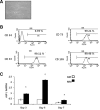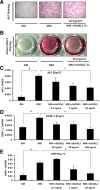The role of lysyl oxidase-like 2 in the odontogenic differentiation of human dental pulp stem cells
- PMID: 23677379
- PMCID: PMC3887878
- DOI: 10.1007/s10059-013-0080-3
The role of lysyl oxidase-like 2 in the odontogenic differentiation of human dental pulp stem cells
Erratum in
- Mol Cells. 2013 Nov;36(5):476
Abstract
Adult human dental pulp stem cells (hDPSCs) are a unique population of precursor cells those are isolated from postnatal dental pulp and have the ability to differentiate into a variety of cell types utilized for the formation of a reparative dentin-like complex. Using LC-MS/MS proteomics approaches, we identified the proteins secreted from the differentiating hDPSCs in mineralization media. Lysyl oxidase-like 2 (LOXL2) was identified as a protein that was down-regulated in the hDPSCs that differentiate into odontoblast-like cells. The role of LOXL2 has not been studied in dental pulp stem cells. LOXL2 mRNA levels were reduced in differentiating hDPSCs, whereas the levels of other LOX family members including LOX, LOXL1, LOXL3, and LOXL4, are increased. The protein expression and secretion levels of LOXL2 were also decreased during odontogenic differentiation. Recombinant LOXL2 protein treatment to hDPSCs resulted in a dose-dependent decrease in the early differentiation and the mineralization accompanying with the lower levels of odontogenic markers such as DSPP, DMP-1 and ALP. These results suggest that LOXL2 has a negative effect on the differentiation of hDPSCs and blocking LOXL2 can promote the hDPSC differentiation to odontoblasts.
Figures




Similar articles
-
Odontogenic differentiation of human dental pulp stem cells induced by preameloblast-derived factors.Biomaterials. 2011 Dec;32(36):9696-706. doi: 10.1016/j.biomaterials.2011.09.007. Epub 2011 Sep 16. Biomaterials. 2011. PMID: 21925730
-
Strontium (Sr) elicits odontogenic differentiation of human dental pulp stem cells (hDPSCs): A therapeutic role for Sr in dentine repair?Acta Biomater. 2016 Jul 1;38:201-11. doi: 10.1016/j.actbio.2016.04.037. Epub 2016 Apr 27. Acta Biomater. 2016. PMID: 27131573
-
Effects of icariin on dental pulp stem cells and its potential applications in dentin repair.Arch Oral Biol. 2025 Jan;169:106112. doi: 10.1016/j.archoralbio.2024.106112. Epub 2024 Oct 17. Arch Oral Biol. 2025. PMID: 39437662
-
Lysyl oxidase and the lysyl oxidase-like protein modulate odontoblastic differentiation of human dental pulp cells.J Endod. 2012 Jun;38(6):769-73. doi: 10.1016/j.joen.2012.03.014. Epub 2012 Apr 21. J Endod. 2012. PMID: 22595110
-
A Perspective on Stem Cells as Biological Systems that Produce Differentiated Osteoblasts and Odontoblasts.Curr Stem Cell Res Ther. 2017;12(3):247-259. doi: 10.2174/1574888X11666161026145149. Curr Stem Cell Res Ther. 2017. PMID: 27784228 Review.
Cited by
-
EMILIN proteins are novel extracellular constituents of the dentin-pulp complex.Sci Rep. 2020 Sep 18;10(1):15320. doi: 10.1038/s41598-020-72123-2. Sci Rep. 2020. PMID: 32948785 Free PMC article.
-
Odontoblast-like Cytodifferentiation of Dental Stem Cells: A Review.Iran Endod J. 2020 Spring;15(2):79-89. doi: 10.22037/iej.v15i2.27569. Iran Endod J. 2020. PMID: 36704441 Free PMC article. Review.
-
Hypoxia-inducible factors in postnatal mouse molar dental pulp development: insights into expression patterns, localisation and metabolic pathways.Pflugers Arch. 2024 Sep;476(9):1411-1421. doi: 10.1007/s00424-024-03003-1. Epub 2024 Aug 5. Pflugers Arch. 2024. PMID: 39101996
-
Lysyl Oxidase Isoforms and Potential Therapeutic Opportunities for Fibrosis and Cancer.Expert Opin Ther Targets. 2016 Aug;20(8):935-45. doi: 10.1517/14728222.2016.1151003. Epub 2016 Mar 3. Expert Opin Ther Targets. 2016. PMID: 26848785 Free PMC article. Review.
-
Characterization of Odontogenic Differentiation from Human Dental Pulp Stem Cells Using TMT-Based Proteomic Analysis.Biomed Res Int. 2020 Dec 10;2020:3871496. doi: 10.1155/2020/3871496. eCollection 2020. Biomed Res Int. 2020. PMID: 33490242 Free PMC article.
References
-
- Atsawasuwan P, Mochida Y, Parisuthiman D, Yamauchi M. (2005). Expression of lysyl oxidase isoforms in MC3T3-E1 osteoblastic cells. Biochem Biophys Res Commun. 327, 1042–1046 - PubMed
-
- Bignon M, Pichol-Thievend C, Hardouin J, Malbouyres M, Brechot N, Nasciutti L, Barret A, Teillon J, Guillon E, Etienne E, et al. (2011). Lysyl oxidase-like protein-2 regulates sprouting angiogenesis and type IV collagen assembly in the endothelial basement membrane. Blood 118, 3979–3989 - PubMed
-
- Chai Y, Slavkin HC. (2003). Prospects for tooth regeneration in the 21st century: a perspective. Microsc Res Tech. 60, 469–479 - PubMed
-
- d’Aquino R, Graziano A, Sampaolesi M, Laino G, Pirozzi G, De Rosa A, Papaccio G. (2007). Human postnatal dental pulp cells co-differentiate into osteoblasts and endotheliocytes: a pivotal synergy leading to adult bone tissue formation. Cell Death Differ. 14, 1162–1171 - PubMed
-
- Duailibi MT, Duailibi SE, Young CS, Bartlett JD, Vacanti JP, Yelick PC. (2004). Bioengineered teeth from cultured rat tooth bud cells. J Dent Res. 83, 523–528 - PubMed
Publication types
MeSH terms
Substances
LinkOut - more resources
Full Text Sources
Other Literature Sources
Research Materials
Miscellaneous

